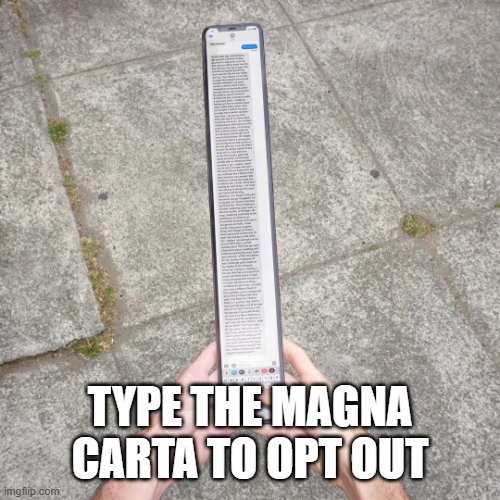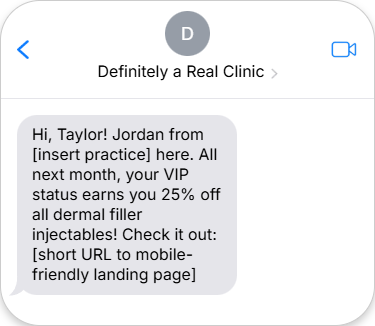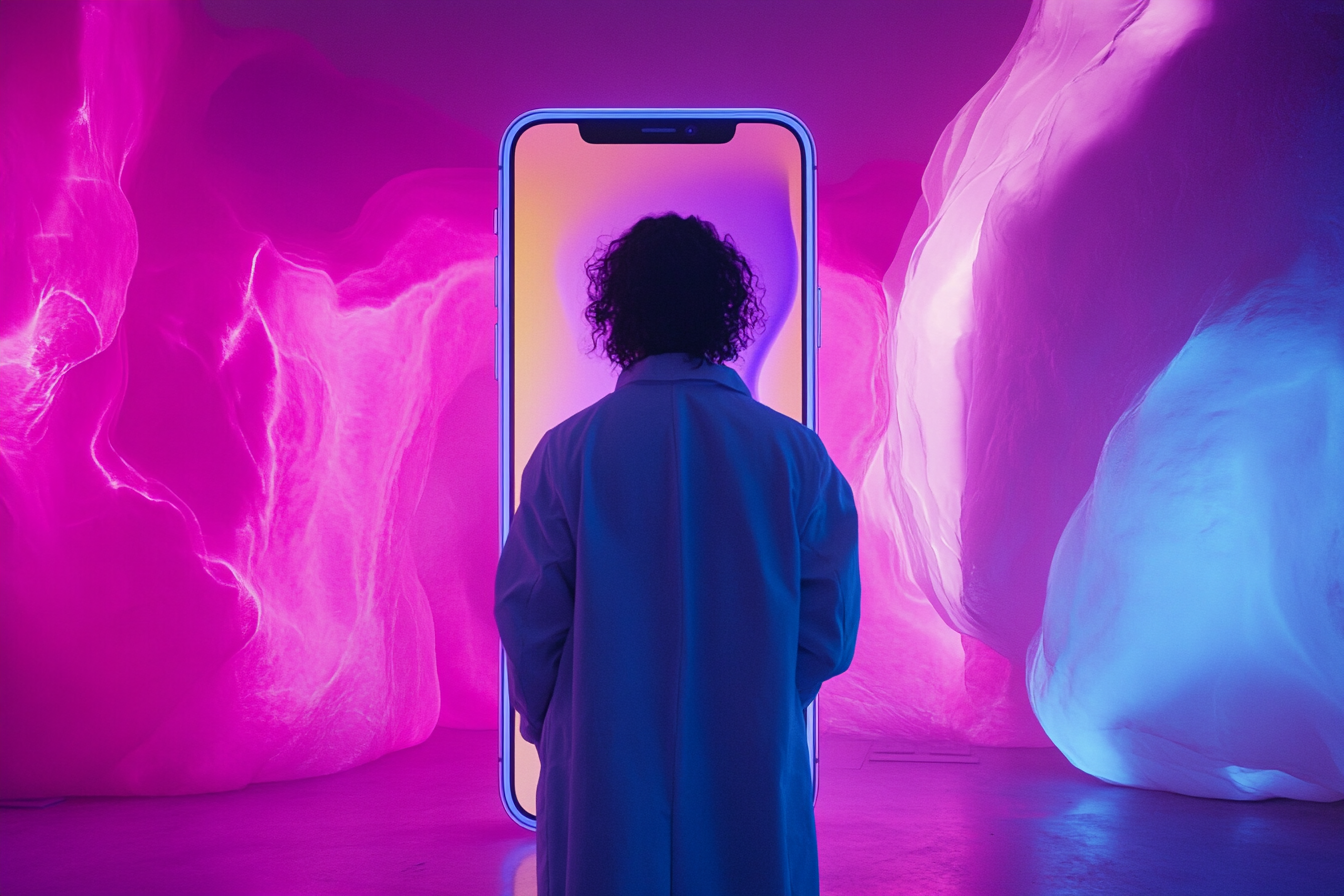It won’t taste as good, they said. It cheapens the experience, they said. But look at them (and you, and us) now. We all got the damn air fryer anyway.
That’s kind of what having the “you should do SMS marketing” conversation with aesthetic practices is like, if we’re being honest. Some of you turn up your perfectly sculpted noses at the prospect of sky-high engagement rates, and darn it, we’re not gonna take it anymore.
Jokes aside, you really do not want to sleep on the myriad of opportunities that SMS marketing promises. When done well, SMS marketing will convert people on the verge of ghosting you into regularly returning patients—if, and only if, you can cut through the noise with a message that is actually worthwhile.
Why You Should Care About SMS Marketing
Let’s address the first, and usually, biggest hurdle to starting down this road: you. Texting from your practice, or God forbid you yourself, feels… tacky? Invasive? Salesy? What’s the word I am searching for here? Well, whatever it is, I think it gives us “the ick”. And why? Because our text messages are our safe space. Friends and family, and maybe that Tinder connection that you still aren’t 100% sure about, live here, not…companies. It feels like everyone in your inbox needs extra special permission to connect on such a personal level.
Hey—get over it! Just because you feel that way, does not mean your patient does. And guess what, if they do not want to hear from you, they will let you know (more on this below). So, suck it up, buttercup, and get the people what they want!
Now, as long as you respect the sacred space that is your patient’s messaging inbox, SMS marketing offers crazy high open rates while allowing you to stay in touch with all segments of your audience far more effectively than any other method.
Crazy Numbers With a Catch

This Consumer Mobile Usage Report from EZ Texting, which entailed a survey of over 1,000 consumers, reveals the stupefyingly high engagement numbers associated with SMS marketing and texting in general:
- Over 95% open rate
- 50% of people aged 18 to 29 check their messages 7+ times per hour
- 65% of consumers check their phones within five minutes of waking up
- 90% of consumers respond to texts within 30 minutes
- Text engagement was 6x that of email
Big shiny numbers good, more money good! But if you don’t understand the experiential factors behind the numbers and how they should inform your SMS strategy, you’ll just flounder and flop around blindly as the budget is drained from your tank.
As we discussed above, texting is very much a sacred medium. Mentally, it’s where your friends and family live. It’s not a place for spam. So how do we make practice text messages that are inherently “selling something” meaningful and non-spammy?
Yes, you could send a message in Sanskrit, and your patients would at least open it, but whether or not you go anywhere from the initial open depends on your ability to respect this space. Profane this holy ground, and you’ll be excommunicated.
Before you get too excited about how to actually get past that initial open, we need to talk about how SMS can smooth out your day-to-day while keeping patients from falling out of your schedule.
Cooler Runnings: SMS Smoothes Over Your Day-to-Day
Feel the rhythm! Feel the rhyme! Get on up…ah, never mind.
It’s okay if you don’t want to admit that your front desk is as overwhelmed as a Jamaican bobsled team. We’ll just leave this here: automated appointment reminders can save you massive amounts of time and effort.
But that’s not all they do. Sleep on appointment reminders, and you’re bound to ice out large chunks of your recipient list. Yes, they may seem like a boring, functional, non-sexy component of your SMS marketing strategy, but in actuality, they are the retention-boosting guardrails you need to keep people from ghosting you.
Forgetters, flakes (just sayin) and nervous first-timers can all be gently guided back into the fold by a well-timed reminder when they would have otherwise poofed back into the ether for good.
Obviously, this bump in retention translates directly into your bottom line, with no pitch required. Because, you know, you already made it successfully the first time. Why just let yourself fumble?
Sold? Sold. That covers the why—now for the how.
Building an SMS Strategy That Actually Works
In order to succeed with SMS, you need to:
- Understand your main constraints
- Deliver concise, value-driven content
- Use targeting and personalization wisely
- Find your ideal frequency
Anyone else feeling cramped in here?
Know Your (Character) Limit
Usually, you’re limited to 160 characters per message. And it hopefully goes without saying that bulk send reeks of desperation.
For added context, the following hot take, which totally doesn’t reflect Incredible Marketing’s opinions in any way, is just a hair less than 160 characters in length:
“This all-encompassing obsession with the casserole has ruined online recipe hunting. Some of us don’t like our food smashed into a gelatinous rectangle, mkay?”
That’s it! That’s all you’ve got to work with.
And remember not to compare SMS with email or longer ad copy in a linear sense; SMS is not “email, but shorter.” You’re not telling a shorter story while retaining multiple elements, but rather transitioning from a story to a singular message.

Deliver one message, and make it succinct. But, uh, what is that message, exactly?
Get to the Point and Deliver Value

Boom. No need to overcomplicate it. Front-loaded value, friendly but fluff-free delivery, and straight to your lander they go. There’s your promotional SMS blueprint. Tweak it as needed.
Now, let’s see an example of what you don’t want to do:

You’ve hopefully picked up on at least a few glaring issues right off the bat, including:
- Spammy all-caps text
- No personalization whatsoever
- Terrible transition to CTA
- Chunky link to poorly optimized page
Worst of all, this poorly penned example doesn’t deliver value. Neither the above vaguely worded delivery (what the hell does “slashing prices” actually mean in terms of dollars and cents?) nor a paltry 10% deal is going to earn you any loyalty.
Bring the BOGO deal. Offer 25% off or better. Promote your aggressive flash sales and limited-time offers. And communicate the actual dollar amounts or percentages.
There are also several points not directly related to the content of the message itself that, for illustrative purposes, we will say this bad example dropped the ball on. They sent it at 3:30 AM on a Tuesday, for example, two weeks after sending you three on three consecutive days. Hot mess.
But even the perfect dermal filler promo, to keep with our example, isn’t going to perk up the ears of someone who couldn’t care less about fillers in the first place.
Hence, targeting.
Send Intentionally
There’s a reason Walmart put the beer next to the diapers (yes, that really happened). They know who is interested in what and when.
On that note, how interested do you think a 58-year-old man who has been coming to you for hair restoration for the last four months is in your half-off lip filler promotion? Is this particular message well-tailored to the male aesthetic patient in general?
This is why you need to use every piece of information you have on each patient to inform a targeted approach to SMS marketing. Every message you send should be able to address these three questions at the very minimum:
- What has this patient done with us?
- When was the last time we saw them?
- What offers or content, if any, have they engaged with?
Armed with the answers to these questions, you can now make several strategic moves. For one, you can ensure that each offer is tailored to what each recipient actually cares about.
You can also re-capture drifters and ghosts with personalized offers and updates (“How have you been? We’ve made some changes we think you’ll like, including “xyz” new treatment and “xyz” offer”).
Stay In the Pocket: Let’s Talk Frequency
There is no standardized send frequency because there is no standardized aesthetic medicine practice. That said, there are reasonable thresholds. Appointment reminders aside, you definitely should not be sending promotions every day. Once you are filed as “spam” in the recipient’s mind, you’re done.
Rather than ruminating over an ill-defined number, it benefits you much more to understand the factors that play into where you should first set the knob and when you should turn it up or down.
Start with one message per month. Align each SMS offer with your email blast.. Is there enough going on with your practice for each message to feel weighty and value-driven, or are they cursed with fluffy energy?
Is each message structured around separate, clearly defined calls to action, or do they just end vaguely because there’s nothing new to point to? The answers to these questions should inform your decision to ramp up frequency, decrease, or stay at once a week. If you feel like you’re reaching, tone it down and vice versa.
Segmentation should have a significant influence on frequency. There’s a difference between sending one promotion a week to an active patient and sending one re-engagement message a week (eeease up a bit) to an estranged patient.
Send frequency isn’t the only issue affected by the type of practice you have. In fact, your offering (and to whom it’s being offered) can determine whether or not you should consider SMS at all.
How Practice Type and Audience Affect SMS Strategy
If you’re a surgically focused practice that caters mostly to an older audience, SMS marketing may not be as effective an option for engagement and retention. Nobody is going to casually whip out their phone and commit to a facelift or abdominoplasty because you texted them.
If you offer nonsurgical treatments designed to complement surgical procedures, however, that may be an opportunity. It’s still not the ideal scenario, especially with older recipients.
Med spas are generally the sweet spot. Ongoing treatment plans (e.g., re-up on Botox every few months, etc.) allow you to sprinkle in promos between appointment reminders naturally while building a stronger relationship with each patient.
You can also use SMS marketing to steer your audience towards highly mobile-optimized landing pages. The vast majority of recipients aren’t going to sit down at their computer and manually type out the link you sent them via text. They’re just going to tap on the link. This allows for a more focused and efficient approach.
Where Is SMS Marketing Headed?
Nobody wants to invest in an approach that will be kaput in two years. We get it. So, is SMS marketing going to stay relevant?
The short answer is most definitely yes. Until we’re all outfitted with neural implants (We’ll return to this childhood memory right after a message from our sponsors!), texting via phone isn’t going anywhere.
The real question is how far, if at all, AI integration is going to take it. Even now, it’s not far-fetched by any means to picture a hyper-individualized experience in which your patients receive tailored replies that adapt to their own responses. This organic back-and-forth may be more of a thing with chat boxes, but we won’t be surprised to see SMS marketing adopt this more personalized approach as well.
"You'll be able to load in specific sales, offers and discounts, and AI will feel like an extension of your office, texting with people and bringing them in."
-Sam Peek, Editor in Chief
The AI will learn and store information based on conversations with each patient, and may be able to generate its own tailored SMS promotions in the future. This enhanced autonomy and customizability should also be applied to appointment reminders and answering patients’ questions. This is just the beginning of AI-Powered Patient Care.
Tying It All Together
SMS marketing promises crazy high engagement, but that only translates to an actual increase in appointments when you deliver value in a simple, highly targeted way.
Practices with a more surgical focus may not benefit as much from SMS marketing (though there are still opportunities there!), and vice versa.
Leverage SMS correctly, and you can re-capture lost people, fill your schedule and increase your trustworthiness with a growing audience.
Frequently Asked Questions
How does consent work with SMS marketing?
You need explicit opt-in consent before sending any texts to patients. Even if they willingly give you their phone number (online or IRL), that doesn’t qualify as consent for SMS marketing unless they approve this specific use of their information in writing. One simple way to obtain consent is to provide a checkbox on intake forms. You also need to provide an easy way to opt out at any time.
How do I know if my SMS strategy is working?
Don’t be floored by the high-as-hell open rate. If you’re not actually converting and retaining, you still need to make a change. Track appointment bookings from SMS campaigns, revenue per text, opt-out rate and response rate. These metrics provide a more realistic view of how your messages are actually performing once opened.
Should I explicitly feature pricing information or tease the offer?
In most cases, SMS is not the time or place to drag things out. Lead with the savings. If it’s $100 off x treatment, tell them! If you’re competing more on expertise and experience for a premium surgical procedure, then it’s much more reasonable to leave out price, but this isn’t the ideal application of SMS marketing to begin with.
When in the process should I text patients? Before or after consultation, after the first treatment, etc.?
The answer is yes. No touchpoint, including all of the above, is off limits if you are targeting your messages well and keeping to a reasonable frequency. Pre-consultation, between consultation and booking, post-treatment, and in between sessions are all fair game.
Too Long? Here's the Short Version
SMS marketing delivers insane engagement rates (95%+ open rates, 6x email engagement), but only works if you respect your patients' sacred inbox space. The key is delivering concise, front-loaded value in 160 characters or less. Target strategically based on patient history and interests (don't send lip filler promos to your hair restoration guys) and align your SMS promos with email campaigns and any other channels you use. Med spas benefit most from SMS since ongoing treatments naturally create touchpoints between appointment reminders. The bottom line: automated reminders prevent ghosting, targeted promos fill your schedule, and personalized messages rebuild relationships with drifters. Just don't spam people at 3:30 AM or you'll get excommunicated faster than you can say "BOGO Botox."
SMS marketing delivers insane engagement rates (95%+ open rates, 6x email engagement), but only works if you respect your patients' sacred inbox space. The key is delivering concise, front-loaded value in 160 characters or less. Target strategically based on patient history and interests (don't send lip filler promos to your hair restoration guys) and align your SMS promos with email campaigns and any other channels you use. Med spas benefit most from SMS since ongoing treatments naturally create touchpoints between appointment reminders. The bottom line: automated reminders prevent ghosting, targeted promos fill your schedule, and personalized messages rebuild relationships with drifters. Just don't spam people at 3:30 AM or you'll get excommunicated faster than you can say "BOGO Botox."










